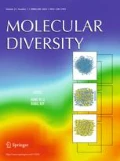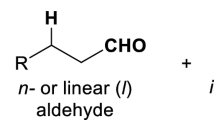Summary
Reactions using fluorous reagents and scavengers are compared side-by-side with their solid-supported counterparts. Fluorous triphenylphosphine is used in the bromination reaction of alcohols, fluorous thiol is used as an electrophile scavenger for α-bromoketones, fluorous isatoic anhydride is used as a nucleophile scavenger for primary and secondary amines. Reactions involving fluorous reagents and scavengers occur in homogeneous media with solution-phase reaction kinetics. Reactions with solid-supported reagents and scavengers occur in a heterogeneous media, and the reaction kinetics are greatly affected by the nature of the solid-support and reaction environment. Significantly larger amounts of reagents and more time are usually required to complete the solid-supported reaction.
Similar content being viewed by others
References
Selected reviews on polymer-assisted organic synthesis: a) Hodge, P., Organic synthesis using polymer-supported reagents, catalysts and scavengers in simple laboratory flow systems, Curr. Opin. Chem. Biol., 7 (2003) 362–373. b) Kirschning, A., Monenschein, H. and Wittenberg, R., Functionalized polymers – emerging versatile tools for solution-phase chemistry and automated parallel synthesis, Angew. Chem. Int. Ed., 40 (2001) 650–679. c) Polymeric Scavenger Reagents in Organic Synthesis, Eur. J. Org. Chem., (2001) 1213–21224. d) Thompson, L.A., Recent applications of polymer-supported reagents and scavengers in combinatorial, parallel, or multistep synthesis, Curr. Opin. Chem. Biol., 4 (2000) 324–337. e) Ley, S.V., Baxendale, I.R., Bream, R.N., Jackson, P.S., Leach, A.G., Longbottom, D.A., Nesi, M., Scott, J.S., Storer, R.I. and Taylor, S.J., Multi-step organic synthesis using solid-supported reagents and scavengers: A new paradigm in chemical library generation, J. Chem. Soc., Perkin Trans. 1, 23 (2000), 3815–4195. f) Booth, R.J. and Hodges, J.C., Solid-supported reagent strategies for rapid purification of combinatorial synthesis products, Acc. Chem. Res., 32 (1999) 18–26. g) Parlow, J.J., Devraj, R.V. and South, M.S., Solution-phase chemical library synthesis using polymer-assisted purification techniques, Curr. Opin. Chem. Biol., 3 (1999) 320–336. h) Flynn, D.L., Devraj, R.V., Naing, W., Parlow, J.J., Weidner, J.J. and Yang, S. Polymer-assisted solution phase (PASP) chemical library synthesis, Med. Chem. Res., 8 (1998) 219–243.
Recent reviews on fluorous synthesis: a) Handbook of fluorous chemistry, Gladysz, J.A., Hovath, I. and Curran D.P. (eds), Wiley-VCH, New York, 2004. b) Zhang, W., Fluorous synthesis of heterocyclic systems, Chem. Rev., 104 (2004), 2531–2556. c) Zhang, W., Fluorous technologies for solution-phase high-throughput organic synthesis, Tetrahedron, 59 (2003) 4475–4489. d) Gladysz, J.A. and Curran, D.P., Fluorous chemistry: from biphasic catalysis to a parallel chemical universe and beyond, Tetrahedron, 58 (2002) 3823–3825. e) Curran, D.P., In Stimulating Concepts in Chemistry, Stoddard, F., Reinhoudt, D., Shibasaki, M. (eds.), Wiley-VCH, New York, 2000, pp 25–37. f) Curran, D.P., Strategy-Level separations in organic synthesis: From planning to practice, Angew. Chem., Int. Ed., 37(1998) 1175–1196.
Curran, D.P., Fluorous reverse phase silica gel: A new tool for preparative separations in synthetic organic and organofluorine chemistry, Synlett, (2001) 1488–1496.
a) Zhang, W. and Tempest, P., Highly efficient microwave-assisted fluorous Ugi and post-condensation reactions for benzimidazoles and quinoxalinones, Tetrahedron Lett., 45 (2004) 6757–6760. b) Zhang, W., Nagashima, T., Lu, Y. and Chen, C.H.-T., A traceless perfluorooctylsulfonyl tag for deoxygenation of phenols under microwave irradiation, Tetrahedron Lett., 45 (2004) 4611–4613. c) Zhang, W., Chen, C. H.-T., Lu, Y. and Nagashima, T., A Highly efficient microwave-assisted Suzuki coupling reaction of aryl perfluorooctylsulfonates with boronic acids, Org. Lett., 6 (2004) 1473–1476. d) Zhang, W., Lu, Y. and Chen, C.H.-T., Combination of microwave reactions with fluorous separations in the palladium-catalyzed synthesis of arylsuljides, Mol. Diversity, 7 (2003), 199–202. e) Larhed, M., Hoshino, M., Hadida, S., Curran, D.P. and Hallberg, A., Rapid fluorous Stille coupling reactions conducted under microwave irradiation, J. Org. Chem., 62 (1997) 5583–5587. f) Olofsson, K., Kim, S.Y., Larhed, M., Curran, D.P. and Hallberg, A., High-speed, highly fluorous organic reactions, J. Org. Chem., 64 (1999) 4539–4541.
a) Linclau, B., Singh, A.K. and Curran, D.P., Organic-fluorous phase switches: A fluorous amine scavenger for purification in solution phase parallel synthesis, J. Org. Chem., 64 (1999) 2835–2842. b) Curran, D.P., Hadida, S., Kim, S.Y. and Luo, Z.Y., Fluorous tin hydrides: A new family of reagents for use and reuse in radical reactions, J. Am. Chem. Soc., 121 (1999) 6607–6615. c) Werner, S. and Curran, D.P., Fluorous dienophiles are powerful diene scavengers in Diels-Alder reactions, Org. Lett., 5 (2003) 3293–3296.
a) Lindsley, C.W., Zhao, Z. and Leister, W., Fluorous scavengers in Handbook of fluorous chemistry, Gladysz, J.A., Hovath, I., Curran D.P. (eds.), Wiley-VCH, New York, 2004, pp 236–246. b) Lindsley, C.W., Zhao, Z. and Leister, W., Fluorous-tethered quenching reagents for solution phase parallel synthesis, Tetrahedron Lett., 43 (2002) 4225–4228. c) Lindsley, C.W., Zhou, Z., Leister, W.H. and Strauss, K.A., Fluorous-tethered amine bases for organic and parallel synthesis: Scope and limitations, Tetrahedron Lett., 44 (2003) 3619–3623.
a) Zhang, W., Fluorous scavengers for solution-phase synthesis, The Worldwide PharmaChem Directory, 2003, pp. 18–20. b) Zhang, W., Curran, D.P. and Chen, C.H.-T., Use of fluorous silica gel to separate fluorous thiol quenching derivatives in solution-phase parallel synthesis, Tetrahedron, 58 (2002) 3871–3875. c) Zhang, W., Chen, C.H.-T. and Nagashima, T., Fluorous electrophilic scavengers for solution-phase parallel synthesis, Tetrahedron Lett., 44 (2003) 2065–2068.
For polymer-supported isatoic anhydride, see Coppola, G.M., A new scavenger resin for amines, Tetrahedron Lett., 39 (1998) 8233–8236.
Gladysz, J.A. Ponytails: Structural and electronic considerations in The handbook of fluorous chemistry, Gladysz, J.A., Hovath, I., Curran D.P. (eds), Wiley-VCH, New York, 2004, pp. 41–55.
Appel, R. and Halstenberg, M., Organophosphorous reagents in organic synthesis, Cadogan, J.I.G., Ed., Academic, New York, 1979, pp. 387–431.
For applications of PS-TPP, see: a) Harrison, C.R., Hodge, P., Hunt, B.J., Khoshdel, E. and Richardson, G., Preparation of alkyl chlorides, acid chlorides, and amides using polymer-supported phosphines and carbon tetrachloride: Mechanism of these reactions, J. Org. Chem., 48 (1983) 3721–3728. b) Caldarelli, M., Habermann, J. and Ley, S.V., Clean five-step synthesis of an array of 1,2,3,4-tetra-substituted pyrroles using polymer-supported reagents, J. Chem. Soc., Perkin Trans., 1, (1999) 107–110. c) Porwanski, S., Kryczka, B. and Marsura, A., A polymer-supported ‘one-pot’ phosphine imide reaction on cyclodextrins, Tetrahedron Lett., 43 (2002) 8441–8443.
For applications of F-TPPs bearing one-, two-, or three-fluorous tags, see: a) Grigg, R. and York, M., Bimetallic catalytic cascade ring closing metathesis – intramolecular Heck reactions using a fluorous biphasic solvent system or a polymer-supported palladium catalyst, Tetrahedron Lett., 41 (2000) 7255–7258. b) Schneider, S. and Bannwarth, W., Repetitive application ofperfluoro-tagged Pd complexes for Stille couplings in a fluorous biphasic system, Angew. Chem. Int. Ed., 39 (2000) 4142–4145. c) Richter, B., de Wolf, E., van Koten, G. and Deelman, B.J., Synthesis and properties of a novel family of fluorous triphenylphosphine derivatives, J. Org. Chem., 65 (2000) 3885–3893. d) Schneider, S. and Bannwarth, W. Application of the fluorous biphase concept to palladium-catalyzed Suzuki couplings, Helv. Chim. Acta., 84 (2001) 735–742. e) Soos, T. and Bennett, B.L., Rutherford, D., Barthel-Rosa, L.P., Gladysz, J.A. Synthesis, Reactivity, and Metal Complexes of Fluorous Triarylphosphines of the Formula P(p-C6H4(CH2)3(CF2)n-1CF3)3(n = 6, 8, 10), Organometallics, 20 (2001) 3079–3086. f) Dandapani, S. and Curran, D. P. Fluorous Mitsunobu reagents and reactions, Tetrahedron 58 (2002) 3855–3864. g) Parallel fluorous biphasic synthesis of 3H-quinazolin-4-ones by an Aza-Wittig reaction employing perfluoroalkyl-tagged triphenylphosphine, Barthelemy, S., Schneider, S., Bannwarth, W., Tetrahedron Lett., 43 (2002) 807–810. h) Desmaris, L., Percina, N., Cottier, L. and Sinou, D., Conversion of alcohols to bromides using a fluorous phosphine, Tetrahedron Lett., 44 (2003) 7589–7591.
Lindsley, C.W., Zhao, Z., Newton, R.C., Leister, W. and Strauss, K.A., A general protocol for solution-phase parallel synthesis, Tetrahedron Lett., 43 (2002) 4467–4470.
Selected reviews: a) Walsh, D., Wu, D. and Chang, Y.-T., Understanding the effects of the polymer support on reaction rates and kinetics: Knowledge toward efficient synthetic design, Curr. Opin. Chem. Biol., 7 (2003) 353–361. b) Yan, B., Single-bead analysis in combinatorial chemistry, Curr. Opin. Chem. Biol., 6 (2002) 328–332. c) Rana. S., White, P. and Bradley, M., Influence of resin cross-linking on solid-phase chemistry, J. Comb. Chem., 3 (2001) 9–15. d) Groth, T., Grotli, M. and Meldal, M., Diffusion of reagents in macrobeads, J. Comb. Chem., 3 (2001) 461–468. e) Vaino, A.R. and Janda, K.D., Solid-phase organic synthesis: A critical understanding of the resin, J. Comb. Chem., 2 (2000) 579–596. f) Bing, Y., Monitoring the progress and the yield of solid phase organic reactions directly on resin supports, Acc. Chem. Res., 31 (1998) 621–630.
Author information
Authors and Affiliations
Corresponding author
Rights and permissions
About this article
Cite this article
Chen, C.HT., Zhang, W. Fluorous reagents and scavengers versus solid-supported reagents and scavengers, a reaction rate and kinetic comparison. Mol Divers 9, 353–359 (2005). https://doi.org/10.1007/s11030-005-8104-3
Received:
Accepted:
Issue Date:
DOI: https://doi.org/10.1007/s11030-005-8104-3




